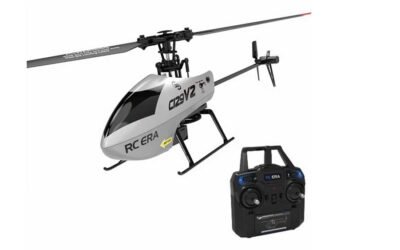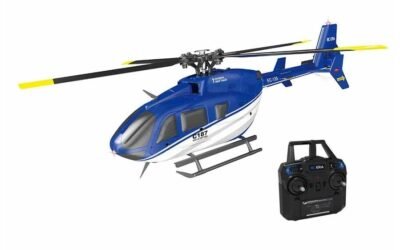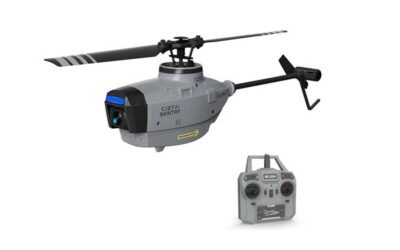The Evolution of Gyro Technology in RC Helicopters: A Historical Perspective
The article “The Evolution of Gyro Technology in RC Helicopters” traces the development from mechanical to electronic gyros, enhancing control and accessibility in remote-controlled aviation.
“Stability in the air: The legacy of gyro technology.”


Introduction
The gyro in RC helicopters represents a significant technological advancement in the world of remote-controlled aviation. Its evolution over the years has drastically transformed how these machines are flown, making them more stable, agile, and accessible to a wider range of enthusiasts.
This article delves into the rich history of gyro technology in gyro RC helicopters, exploring its origins, advancements, and impact on the hobby.
The Early Days of Gyro Technology
The journey of gyro technology in RC helicopters began in the mid-20th century. Initially, RC helicopters were challenging to fly, requiring extensive skill and experience.
Early gyros were mechanical in nature, using spinning rotors to create gyroscopic forces that helped stabilize the helicopter. However, these early systems were rudimentary and offered limited control.
The Introduction of Electronic Gyros
The 1970s and 1980s saw a significant shift with the introduction of electronic gyros. These devices used piezoelectric elements to sense rotational movement, providing a more responsive and precise means of stabilization.
This era marked the beginning of a more accessible hobby, as electronic gyros allowed for easier control of the helicopters.

Advancements in Gyro Technology
Rate Gyros: These gyros, which became popular in the 1990s, could sense the rate of rotation and provide corresponding feedback to the tail rotor. They improved upon earlier models by offering smoother and more predictable control.
- Heading Hold Gyros: A major breakthrough came with the development of heading hold (HH) or ‘tail lock’ gyros. These gyros not only sensed rotation but also maintained the helicopter’s heading, revolutionizing aerobatic capabilities and flight stability.
- 3-Axis Gyros and Flybarless Systems: The 21st century introduced 3-axis gyros, which controlled not just the tail rotor but also the main rotor, offering unprecedented stability and control. This advancement paved the way for flybarless systems, reducing mechanical complexity and improving efficiency.
Impact on the Hobby and Industry
The evolution of gyro technology has had a profound impact on the RC helicopter hobby and industry. It has made flying more accessible to beginners and allowed experienced pilots to perform more complex maneuvers.
The increased stability and control have also expanded the use of RC helicopters in various applications, including aerial photography and drone technology.
Key Milestones in Gyro Technology
The First Electronic Gyros: These were a game-changer, making RC helicopter flying a more feasible hobby for many.
- The Advent of MEMS Gyros: Micro-Electro-Mechanical Systems (MEMS) gyros brought further miniaturization and precision, allowing for smaller and more agile helicopters.
- Integration with Flight Control Systems: Modern gyros are often part of sophisticated flight control systems, integrating GPS and other sensors for advanced flight modes, including autonomous flight.

Challenges and Solutions
The journey of gyro technology was not without its challenges. Early electronic gyros were sensitive to environmental factors like temperature. Over time, these issues were addressed with more robust designs and advanced algorithms.
The Future of Gyro Technology in RC Helicopters
The future of gyro technology is promising, with continuous innovation in sensor technology, software algorithms, and integration with other flight control systems.
The potential for even more stable, efficient, and intelligent RC helicopters is vast, with implications extending beyond hobbyist applications to professional and commercial uses.
Key Takeaway Points
|
Aspect |
Key Takeaway |
|
Early Gyro Technology |
Mechanical gyros with limited control |
|
Introduction of Electronic Gyros |
Enhanced responsiveness and accessibility |
|
Advancements in Gyro Technology |
From rate gyros to 3-axis systems for comprehensive control |
|
Impact on Hobby and Industry |
Broader usage and more complex maneuvers |
|
Future of Gyro Technology |
Potential for more intelligent and efficient helicopters |
Conclusion
The history of gyro technology in RC helicopters is a testament to human ingenuity and the relentless pursuit of technological advancement. From rudimentary mechanical systems to sophisticated electronic solutions, gyro technology has revolutionized the way we fly RC helicopters, making the hobby more enjoyable, accessible, and versatile.
FAQs
- What was the first type of gyro used in RC helicopters?
- The first gyros used in RC helicopters were mechanical, relying on spinning rotors to create stabilizing forces.
- How did electronic gyros change the RC helicopter hobby?
- Electronic gyros made RC helicopters easier to control, making the hobby more accessible to a wider range of people.
- What are heading hold gyros, and why are they significant?
- Heading hold gyros maintain the helicopter’s heading, greatly improving stability and control, especially in aerobatic flight.
- What is a 3-axis gyro, and how does it differ from previous gyros?
- A 3-axis gyro controls yaw, pitch, and roll, offering complete stabilization and paving the way for flybarless systems.
- What might the future hold for gyro technology in RC helicopters?
- Future advancements could include further integration with flight control systems, improved sensor technology, and autonomous flight capabilities.

You may be interested in an Advanced Digital Gyroscope
Don’t miss out on the thrill of piloting your own sky adventure – RC Helicopter City offers an exhilarating blend of skill, precision, and fun, perfect for both beginners and seasoned enthusiasts. Embrace the joy of flight today and experience the unmatched excitement of controlling your very own high-performance RC helicopter, a hobby that promises endless hours of entertainment and skill development.
You May Also Like
Related Posts
RC ERA C129 V2 Review: What Makes It Stand Out
Explore the RC ERA C129 V2’s advanced features, its suitability for beginners, and how it’s revolutionizing remote-controlled flight.
Why Choose RC ERA C187 for Your Hobby
Explore the exciting world of the RC ERA C187 Helicopter. This guide offers tips, reviews, and techniques for beginners and pros alike.
RC ERA C127AI Review: Tech Specs and User Feedback
Explore the revolutionary RC ERA C127AI with advanced tech, user-friendly features, and expert reviews. Learn why it’s the top choice for RC enthusiasts.



